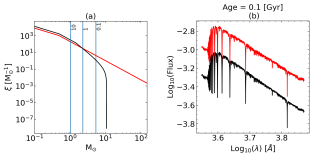Imagen compuesta, de la Nebulosa de Orión, en las líneas de emisión de [NII], de Ha, y de [OIII], codificadas respectivamente en rojo, verde, y azul. Los detalles en blanco y negro, aparte, ilustran los campos de movimiento propio derivados en dos zonas d
Fecha de publicación
Referencias
Proceedings IAU Symposium No. 237, 2006
Usando imágenes en las líneas de emisión de Ha y de [OIII] l5007A del archivo del HST, separadas por 6.84 años, se ha podido detectar, por vez primera, variabilidad en la temperatura y en la densidad del gas ionizado en escalas de centésimas de pc. Las variaciones en temperatura son del orden de decenas de grados C. Se han propuesto posibles mecanismos para explicar esta variabilidad, que incluyen la reconexión de campos magnéticos inducidos por la turbulencia supersónica en la región HII. Asimismo, se ha podido detectar y cartografiar el campo de movimientos propios del gas impulsado por vientos de las estrellas jóvenes o en formación (objetos Herbig-Haro) dentro de la nebulosa (L. Gutiérrez, J.E. Beckman, C. Giammanco.)
Más información
HST emission line images of the Orion HII region: proper motions and possible variability
Using HST emission line images of the Orion Nebula, separated by 7 years in epoch, we have obtained evidence of localized temporal variability of both density and temperature during this period. Applying a digital filter to reduce high frequency noise, we used images in Hα and [OIII] to quantify separately the variability in these two parameters. We detected fractional temperature variations of order 0.4% on scales of 2x10−2 pc. The same images yielded proper motion information; using cross-correlation to optimize the accuracy of the differential measurements we produced velocity field maps across the nebula, with vectors ranging up to ∼130 km s−1 across the line of sight. It is notable that in zones of rapid proper motion we find by far the largest density variations, as would be expected. It is much easier to quantify the temperature variations, on the other hand, in zones with low or zero detectable proper motion (see the other figure here), though these temperature variations appear across the whole face of the nebula.
Año
2007
![Imagen compuesta, de la Nebulosa de Orión, en las líneas de emisión de [NII], de Ha, y de [OIII], codificadas respectivamente en rojo, verde, y azul. Los detalles en blanco y negro, aparte, ilustran los campos de movimiento propio derivados en dos zonas d 7722](/sites/default/files/styles/crop_rectangle_21x9_to_1280/public/images/news/resultados2_2.jpg?itok=_gB2K7Vp)


